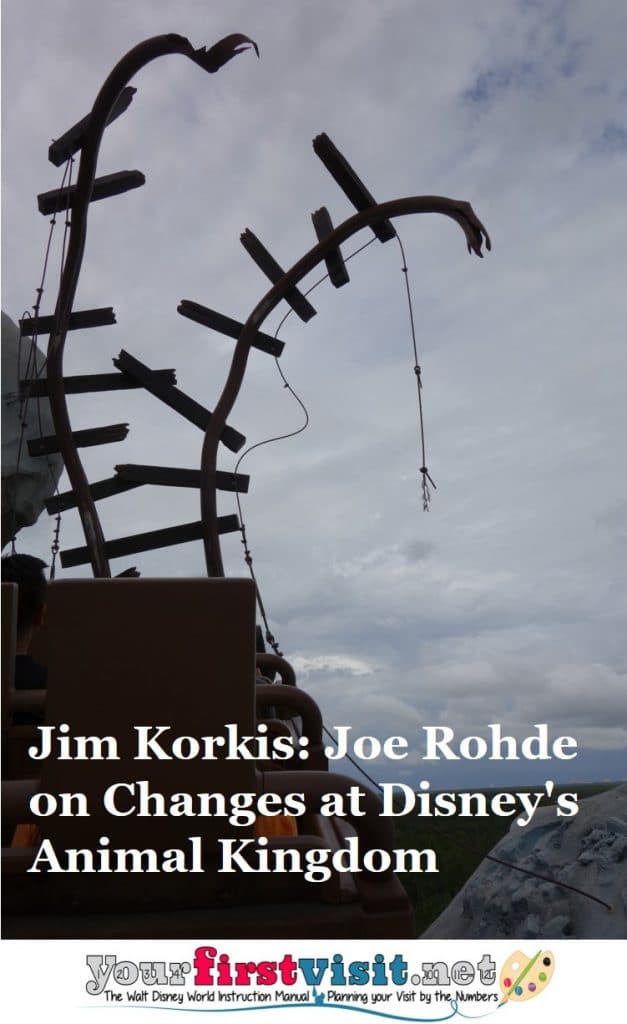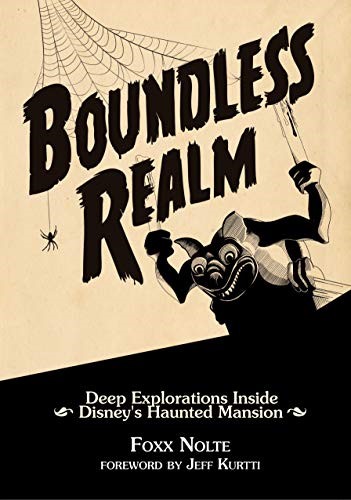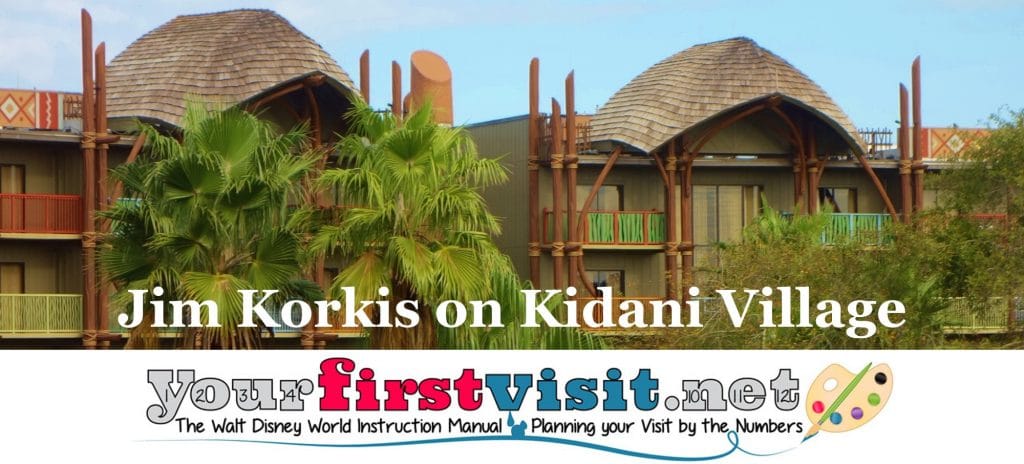Category — A Friday Visit with Jim Korkis
Fridays with Jim Korkis: Joe Rohde on Changes at Disney’s Animal Kingdom
Welcome back to Fridays with Jim Korkis! Jim, the dean of Disney historians, writes about Walt Disney World history every Friday on yourfirstvisit.net.
CHANGES AT DISNEY’S ANIMAL KINGDOM
By Jim Korkis
I attended a cast member only presentation with Imagineer Joe Rohde on April 3, 2006 where he addressed some of the changes at Disney’s Animal Kingdom:
Rohde: “I’m not of the school that believes you build it, you fix it, you pour resin over it, it’s stuck in there forever, nobody touch it, nobody deal with it…that’s dead. You know? That’s like one of those dead scorpions in resin. And I’d rather have the live scorpion, but the live scorpion does things, right? And you have to deal with it alive.
“Some of that stuff is response to operational things. The Big Red thing in Kilimanjaro Safaris was an operational problem. When we opened the park, we had these gorgeous, gorgeous dead animals. There was this eviscerated zebra that lay across the lion exhibit. It was fantastic, and it just looked like it had been torn to shreds…and spread all over the place.
“Its head was over here and its body was here and one leg was over there. It was the drinker, right? So the lions would come down to drink their water out of the thing and it would look like they were eating the dead zebra and it was perfect.
“And there was this dead gazelle in the cheetah exhibit with another drinker that just looked great and they’re made of bronze. They would last a thousand years.
“Then there was Big Red, the dead elephant. Everyone thought they were real dead animals. And so they would get off the thing and go to the operators and go, “You’ve got to do something! There’s a dead animal!” No. You’re trying to unload a vehicle. “Please move on. Go see the gorillas,” you know. “Go buy a Coke. And they’re fine.”
“And thinking they were real pulled guests out of the story structure and into some real world where there’s a real dead animal. The whole poacher scene thing—not the presence of the poachers, which was always there—but the BIG story came from (CEO Michael) Eisner’s desire to ramp that up.
“He took that germ of the story and ramped it up, ramped it up and wanted us to make a big car chase, big thing out of it. Where I’m not necessarily convinced it necessarily needs to occupy that level in the type of ride that that is, and so as it changes and modifies, I think the important thing to continue to have present is the fact that these animals live in a world with us and that our attitudes towards these animals have everything to do with whether they live or die.
“I mean, we put those Discovery boats into Animal Kingdom. I thought they were great. People hated them. Hate, hate, hated these boats. You know…okay, so we took ‘em out, right? A complete failure. A total failure.
“It’s not just bad, it’s gone. They’re gone. The boats are gone, they don’t run any more. The docks sit there. The water’s empty. The boats don’t run. But what we do is continually torture ourselves to go, “Okay, okay…there has to be a way to make this work. There has to be a way to make this work, or to replace it with something that does work.’’ And that is why there is continual change, right?
“Sometimes we think it’s great and the public thinks it sucks. And sometimes you it really is bad and everyone knows it’s bad, and it still got built somehow. You know, I mean all of those things happen. And part of the reason they happen is because it is a necessary cultural by-product of a creative enterprise that it is open to change, open to suggestion, open to variation, open to radical challenges to the status quo.”
* * * * *
Thanks, Jim! And come back next Friday for more from Jim Korkis!
In the meantime, check out his books, including his new books Vault of Walt Volume 9: Halloween Edition, and Hidden Treasures of the Disney Cruise Line.
Follow yourfirstvisit.net on Facebook or Twitter or Pinterest!!
April 9, 2021 No Comments
Fridays with Jim Korkis: Disney’s Caribbean Beach Resort
Welcome back to Fridays with Jim Korkis! Jim, the dean of Disney historians, writes about Walt Disney World history every Friday on yourfirstvisit.net.
DISNEY’s CARIBBEAN BEACH RESORT
By Jim Korkis
Disney’s Caribbean Beach Resort opened October 1, 1988 with calypso music and games as the first Disney moderate resort hotel. When the resort opened it was the fifth largest hotel complex in the United States. It was designed by Fugleberg Koch Architects of Winter Park, Florida.
In keeping with the Caribbean theme, the resort is split into five island-themed “villages”: Aruba, Martinique, Barbados, Trinidad and Jamaica. These two story buildings blend tranquil pastel walls and white-wood railings. They feature vividly colored metal roofs.
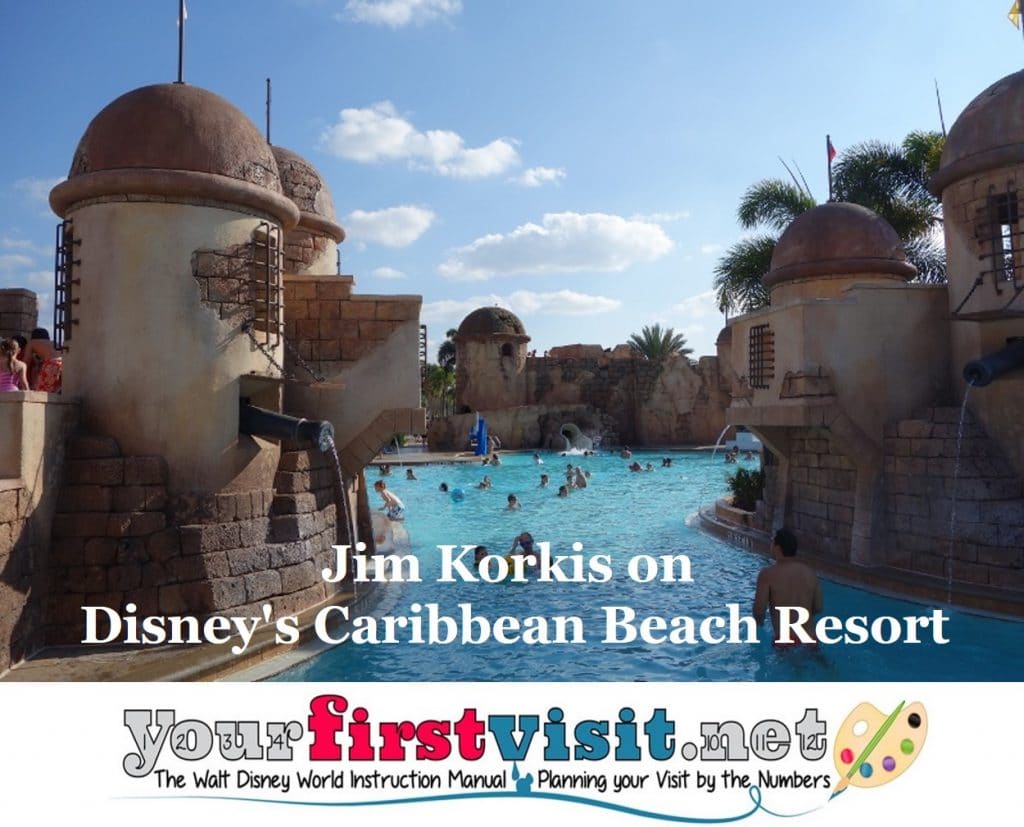
In the center of the man-made lake is Caribbean Cay, an island with a playground, picnic area, and lots of lush foliage. Caribbean Cay is connected to the promenade on each side by a footbridge.
Cay (pronounced “key”) refers to a small, low-elevation, sandy island on the surface of a coral reef and comes from the Spanish word “cayo.” It is a popular term for islands in the Caribbean area. Key West was originally called “Cayo Hueso”.
“We’re building a fun experience, a vacation,” said Wing Chao, vice president of the Disney Development Company when the resort opened. “A hotel is an extension of the guest experience. When they leave the Magic Kingdom they can continue their fantasy at their accommodation. We want the theming to be so pervasive that guests feel like they’re walking onto a movie set.”
That movie set was meant to reflect the brightly colored and laid back atmosphere of the Caribbean with references to its history as a haven for pirates. That includes a pirate themed pool area with cannons that shoot water. A pirate-ship-themed playground sits in the middle of a kids’ pool.
Older kids can climb a spiral staircase to the top of a turret for an 82-foot trip down the larger slide and through the fortress wall.
In January 2009, Disney refurbished many rooms in the Trinidad village with a pirate theme that included nautical details and pirate ship-shaped beds. Unique touches in the room include the dresser resembling crates and the mini-fridge fitting inside a barrel.
Until 1997, guests could purchase jewelry called “Plata del” that was handcrafted from 370 year old silver coins salvaged from a Spanish galleon that sank off the cost of Florida in 1622. Each piece of jewelry was struck directly from “Piece of Eight” recovered from the shipwreck site and came with a certificate of authenticity.
The Custom House that served as the resort’s reception building, where guests check in and check out, featured architectural elements like verandahs, handrails, canopies and tile floors that were typical to government buildings of the Caribbean islands.
In 2018, a major refurbishment project resulted in Old Port Royale now acting as “the port of entry” for the resort, where guests can access check-in, concierge services and other resort amenities
The Old Port Royale pool is themed after a Spanish fortress Fuentes del Morro. Port Royale is also a setting for both the movie and the Magic Kingdom theme park attraction “Pirates of the Caribbean.”
* * * * *
Thanks, Jim! There’s much more on Disney’s Caribbean Beach Resort beginning here.
And come back next Friday for more from Jim Korkis!
In the meantime, check out his books, including his new books Vault of Walt Volume 9: Halloween Edition, and Hidden Treasures of the Disney Cruise Line.
Follow yourfirstvisit.net on Facebook or Twitter or Pinterest!!
April 2, 2021 No Comments
A Friday Visit with Jim Korkis: Boundless Realm by Foxx Nolte
Welcome back to Fridays with Jim Korkis! Jim, the dean of Disney historians, writes about Walt Disney World history every Friday on yourfirstvisit.net.
YOUR PERSONAL DISNEY LIBRARY (38)
By Jim Korkis
- Boundless Realm by Foxx Nolte
Before I purchased this book, I asked the same question that some of you may be asking: Is there really a need for another book about the Haunted Mansion when both The Haunted Mansion: Imagineering a Disney Classic by Jason Surrell and The Unauthorized Story of Disney’s Haunted Mansion by Jeff Baham already exist?
Both of those books are accurate and insightful explorations into the iconic Disney theme park attraction, and I include them as valuable references on my bookshelves and recommend them.
Admittedly, this new book does not strive to be a definitive primer on the attraction, but rather to focus on a more personal observation of just the Haunted Mansion attraction at Walt Disney World. In fact, the author assumes the reader already knows the basic history and operation of the attraction.
The author is a long-time fan of the attraction, spent some time actually working on the WDW attraction and refreshingly admits that she disliked the tedium involved with the role.
I found Boundless Realm very well written, enjoyable and felt my money was well spent. I’ve always enjoyed the author’s work on her Passport to Dreams Old and New website that she has been operating since 2006, and her different perspective on things.
She has been a true Disney historian in every sense of the phrase for years. I must admit that some of her opinions in Boundless Realm opened my mind to new possibilities to consider.
One argument that particularly intrigued me was that WDW’s Haunted Mansion does not exist in the Hudson River Valley but it is more likely to be on the Atlantic coast near Boston. The discussion of the architecture of a “sea wall” along the river and the revelation that a Columbia Sailing Ship like the one in Disneyland was originally meant to be included, which is why the nearby restaurant was called the Columbia Harbor House, is very convincing.
Because of actually working in the mansion and having the opportunity to personally explore the nooks and crannies, the author comes up with some technical information that does not exist in the other two books, including a lengthy explanation of the moving lights effect in the windows of the mansion. That’s just one of the reasons if you are a Haunted Mansion fan you need to include this book with the other two.
I also liked that while the author intends to confine her discussions just to the WDW Haunted Manion, that when necessary she makes connections to the other Disney theme park Haunted Mansion experiences, and how the effects are created differently there.
The author’s genuine affection for the attraction and her curiosity about why things are they way they are and how they have changed (not always for the better) is evident on every page. She has done her research, and more importantly, has done first hand original research. I especially appreciated her making historical connections to sources like films and the Pretzel Amusement Company.
Boundless Realm is over three hundred pages long and has five appendices as well as fourteen pages of additional notes, so that it is overflowing with information. The book also includes many black-and-white illustrations and photos.
This is her first book and without hesitation I would buy any other book she chooses to write in the future.
* * * * *
Thanks, Jim! and come back next Friday for more from Jim Korkis!
In the meantime, check out his books, including his two new books, Vault of Walt Volume 9: Halloween Edition, and Hidden Treasures of the Disney Cruise Line.
Follow yourfirstvisit.net on Facebook or Twitter or Pinterest!!
March 26, 2021 No Comments
Famed Disney Character Orally ASSAULTED
Welcome back to Fridays with Jim Korkis! Jim, the dean of Disney historians, writes about Walt Disney World history every Friday on yourfirstvisit.net.
EATING MICKEY MOUSE AT WALT DISNEY WORLD
By Jim Korkis
One of the most creative appearances at Walt Disney World of Mickey Mouse is not in the stage shows, parades, his own attraction, merchandise or even the countless Hidden Mickeys, but in multiple food offerings at the parks and resorts.
Certainly, Mickey Mouse’s three-circle head silhouette is one of the most recognizable shapes on the planet, and it appears in the form of everything from ice cream to pasta to vegetables to pancakes and much, much more. It all began with Mickey Mouse pancakes in Frontierland at Disneyland in 1955, expanded to Mickey Mouse ice cream bars, and has since grown into a lengthy menu.
At Walt Disney World, Mickey Mouse-shaped food can fill a breakfast, lunch or dinner, and several desserts.
Each year guests consume roughly three million Mickey Premium Ice Cream Bars, one million Mickey Ice Cream Sandwiches, over 700,000 Mickey shaped pats of butter, and about 50,000 pounds of Mickey pasta.
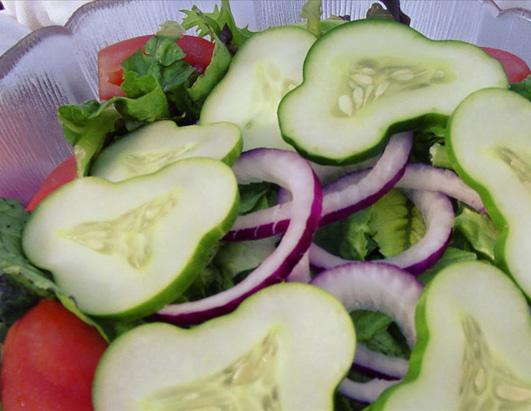
(c) ABC
Walt Disney World Executive Chef Michael Pythoud said that the trend will continue and expand, but with some limitations. “The food is successful with the kids and adults but we don’t want to overfill how many food items are Mickey-shaped because if the guests see Mickey Mouse everywhere, it’s not as much fun or special anymore.”
Product Developer for Attractions Merchandise Sheila Hamblen said, “It just adds that extra touch to what we do. Guests love it when they see it.”
Chef de Cuisine Brian Piasecki feels the food is a major guest satisfier: “It’s really a kind of ‘wow’ factor or ‘look how cool that is’ kind of thing. It’s all about the guest and if we can adjust presentation or produce something fun with that Mickey-shape, it really enhances the guest experience, which is really what our job is. It definitely brings a smile to faces.
“At Epcot, we’ve done things like working with Horticulture to create a mold that grew cucumbers into a Mickey head-shape, and serving kids’ food on a Mickey-shaped plate.
“Even at Rose and Crown we’d pipe mashed potatoes into the form of a Mickey head onto the plate for the kids. Every opportunity that we can use to incorporate that Mickey shape into the food has really always been our practice.”
Among the many items that can be purchased across property include Mickey-shaped pasta salad, macaroni and cheese, waffles (most places also offer a gluten free version), sandwiches, birthday cake, Rice Krispies Treats, brownie, cookies, pretzels, cupcakes, sugar cubes, pizza, cinnamon roll, lollipop, funnel cake, candy apples, cake pops, donuts and even a Mickey Mousse as part of a dinner buffet.
In The Land pavilion, the Mickey head shape in the mold is extruded throughout the length of the growing cucumber, so that when the lumpy and odd-looking cucumber is sliced, each flat slice resembles Mickey Mouse’s head. That began in 2003. In addition, The Land has since produced Mickey Mouse head shaped pumpkins (starting in 2004 and some weighing up to 80 pounds) and watermelons.
Some of these items come in different varieties and it has been conservatively estimated that over sixty different Mickey food items are available at WDW. Long time Walt Disney World guests also know that if a Mickey-shaped treat is only offered on the children’s menu, an adult can still order and enjoy it.
* * * * *
Thanks, Jim! And come back next Friday for more from Jim Korkis!
In the meantime, check out his books, including his new books Vault of Walt Volume 9: Halloween Edition, and Hidden Treasures of the Disney Cruise Line.
Follow yourfirstvisit.net on Facebook or Twitter or Pinterest!!
March 19, 2021 No Comments
A Friday Visit with Jim Korkis: Shrunken Ned’s Junior Jungle Boats
Welcome back to Fridays with Jim Korkis! Jim, the dean of Disney historians, writes about Walt Disney World history every Friday on yourfirstvisit.net.
SHRUNKEN NED
By Jim Korkis
A totem of Shrunken Ned’s head is hung in Trader Sam’s Grog Grotto in Disney’s Polynesian Village Resort, where his voice is provided by Imagineer Brandon Kleyla who designed the location.
Few Disney fans know that Shrunken Ned was a character that actually originated at Walt Disney World. I wrote a book, Secret Stories of Extinct Walt Disney World, about things that no longer exist at the vacation destination, but I wasn’t able to include this story.
Shrunken Ned’s Junior Jungle Boats, a remote control miniature boat experience, existed next to the Jungle Cruise attraction in Adventureland from 1997 to 2012. It occupied the area between the Jungle Cruise and the Swiss Family Treehouse and was eventually replaced in spring 2013 by stations for the interactive game, A Pirate’s Adventure: Treasures of the Seven Seas.
A sign identified the game as the “Jungle Expedition Skipper Training School, established 1854”. Named for and apparently owned by Shrunken Ned, the attraction gave guests a way to experience maneuvering miniate models of the famous Jungle Cruise launches through a variety of obstacles.
The game was not part of the regular admission to the park but cost two tokens (with a nearby machine exchanging one dollar for one token so it cost two dollars to buy time to play with the boats) and featured sixteen individual control stations each featuring a big steering wheel and throttle.
Each station was numbered and corresponded to the same numbered boat.
Guests could attempt to navigate through an obstacle course containing such features as a volcano, spears, Tiki God statues, an Elephant Shrine, ancient ruins, and headhunters. A path to guide the boats was lined with the spears sticking out of the water. Guests could steer the boat in any direction along the designated path.
It was so popular that a similar experience called Safari Adventure was operated at the Disneyland Hotel from 1999 to 2010.
The boats were named Amazon Annie, Congo Connie, Bomokandi Bertha, Mongala Millie, Ganges Gertie, Kwango Kate, Volta Val, Nile Nellie, Orinoco Ida, Ucyali Lolly, Sankuru Sadie, Rutshuru Ruby, Irrawaddy Irma, Senegal Sal, Wamba Wanda and Zambesi Zelda.
Shrunken Ned was meant to be play on the words “shrunken head” that also referenced that guests were playing with shrunken boats. The Walt Disney World attraction sparked a mythology behind the named character.
Colonel Nedley Lostmore was a British colonist, reportedly from the late 1800s/early 1900s, who had some connection to the company that ran the Jungle Cruise. It is surmised that he had something to do with the training and possible hiring of new skippers. He had a distinctively huge white mustache and wore a monocle.
At some unknown point in time, Ned was decapitated and had his head shrunk–but in an unusual supernatural process. His sentient but preserved shrunken head was mounted in the South Seas Traders shop at Disneyland’s Adventureland.
Apparently the experience somehow helped him to become a fortune-teller and witch doctor. He identifies himself as “The Jungle’s Only Self-Service Witch Doctor”, diagnosing guests with strange jungle diseases and offering equally strange solutions.
He might diagnose a guest with some type of fever who is hallucinating that he was in Disneyland, when he is just lost in the jungle and sleepwalking.
He is one of four fortune telling machines found in Disneyland park, and his voice is provided by Imagineer Eddie Sotto.
Dropping two quarters into his “office,” Ned prompts the guest to place their hand on a carved hand-shaped plaque in front of the glass. Guests will feel an eerie pulsing heartbeat and then be told to take the prescription card that is produced. There are twelve different versions.
One one side is the face of Ned and on the other the advice on twelve different cards.
* * * * *
Thanks, Jim! And come back next Friday for more from Jim Korkis!
In the meantime, check out his books, including his new books Vault of Walt Volume 9: Halloween Edition, and Hidden Treasures of the Disney Cruise Line.
Follow yourfirstvisit.net on Facebook or Twitter or Pinterest!!
March 12, 2021 No Comments
A Friday Visit with Jim Korkis: Kidani Village at Disney’s Animal Kingdom Lodge
Welcome back to Fridays with Jim Korkis! Jim, the dean of Disney historians, writes about Walt Disney World history every Friday on yourfirstvisit.net.
KIDANI VILLAGE
By Jim Korkis
In 2009, Kidani Village opened near Disney’s Animal Kingdom as a Disney Vacation Club resort.
Kidani is the Swahili word for “necklace,” and was chosen because of the resort’s distinctive shape. It was designed as an African necklace with vacation villas forming the beads, walkways creating the knots in between, and the lobby representing the ornament or jewel at its center.
The lobby and the villas extend outwards and resemble the curlicue shape of a water buffalo’s horns.
With the opening of the resort, Disney’s Animal Kingdom Lodge was renamed Jambo House, and the two resorts are now collectively know as Disney’s Animal Kingdom Lodge.
Kidani Village offered it own unique savanna view of giraffes, elands, impalas, greater kudus, wildebeests, marabou storks, flamingos, waterbucks and more. There are two savannas, each with a different variety of animals, Sunset and Pembe, and guests are given a Wildlife Spotting Guide.
It has its own lobby and registration area as well as Samawati Springs pool, Uwanja (meaning “play area”) Camp water-play area, Survival of the Fittest fitness center, a table service restaurant Sanaa (“African inspired cuisine with an Indian touch”) and Johari Treasures merchandise shop.
Kidani Village was designed with three themes, Fabric, Proverbs, and Art from various African cultures. The art does not refer to just paintings hanging on the wall but also hand-carved masks, tribal symbols, sculptures and statuary in alcoves and on recessed shelves specifically designed for them.
The proverbs hold special significance due to their importance in African life. One of the most notable that is inscribed at the resort’s main entrance comes from the Asante people of Ghana: “Proverbs are like butterflies. Some are caught. Some fly away.”
Referencing this proverb’s philosophy a bronze-cast butterfly can be found next to each proverb located at the resort. Other proverbs include: “Truth keeps the hands cleaner than soap” (Nigera), “Life is like a ballet performance danced only once” (Mali) and “You must judge a person by the works of their hands.”
The “fabric” theme is very prominent in the lobby. The major patterns used throughout Kidani Village are from the fabrics of the kente cloths of Ghana and the kuba cloths of the Congo.
“Beyond the obvious natural beauty of Kidani Village, the story and attention to detail created by Walt Disney Imagineers is truly amazing,” said Kim Marinaccio who was the general manager of Disney’s Animal Kingdom Lodge and Villas. “The themes of art, fabric and proverbs play an important part in telling the story of the African people and Kidani Village.”
Kidani Village was designed by architect Peter Dominick Jr., who designed the original resort, and it is clear that the style is much the same. The towering ceiling, rich dark wood and grand windows are similar, but the artwork and smaller size of public spaces imparts a cozier feel.
Cultural representatives from Africa are the Lobby Greeters, Savanna Guides and Restaurant Greeters, and share information about life in their country and their personal journey to WDW. They also share African folk tales each night at the Arusha Rock firepit.
However, in addition to authentic African culture, images of Simba, Rafiki, Timon, Pumbaa and others from Disney’s animated classic The Lion King appear throughout the resort, especially in the rooms.
* * * * *
Thanks, Jim! There’s more on Kidani Village beginning here.
And come back next Friday for more from Jim Korkis!
In the meantime, check out his books, including his new books Vault of Walt Volume 9: Halloween Edition, and Hidden Treasures of the Disney Cruise Line.
Follow yourfirstvisit.net on Facebook or Twitter or Pinterest!!
March 5, 2021 No Comments

